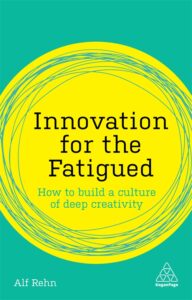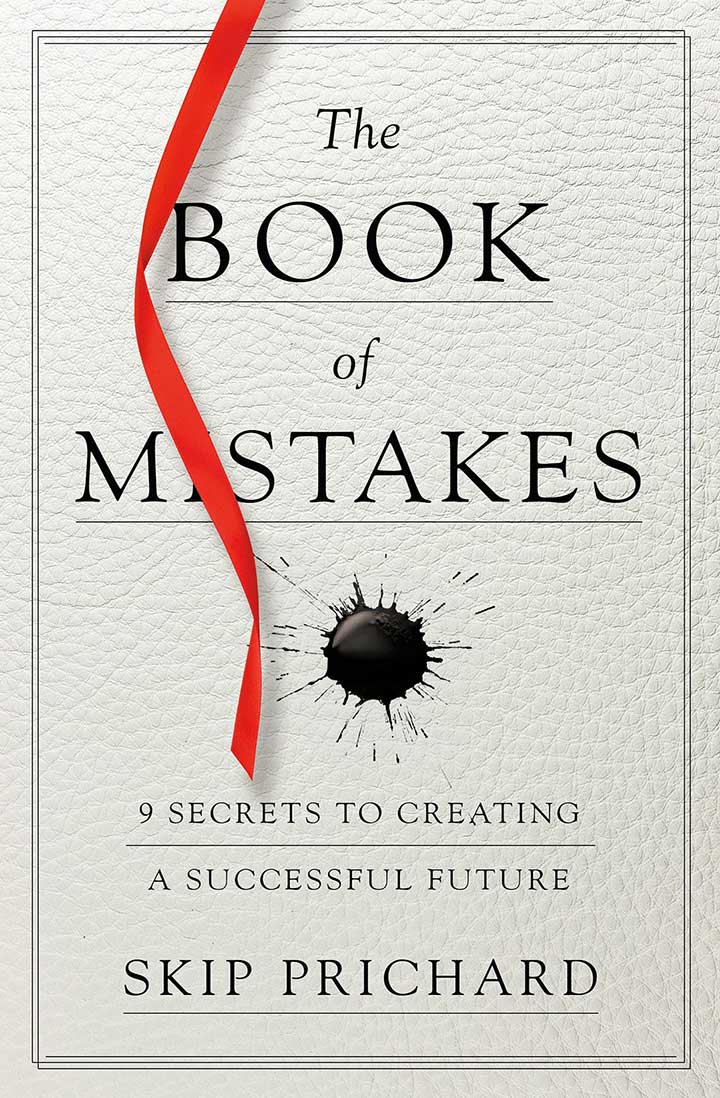Build A Culture of Innovation
Innovation. The buzz word of the decade that is used, overused, and abused, creating what Alf Rehn calls “innovation fatigue.” I had the opportunity to speak with Alf about his new book Innovation for The Fatigued: How to build a culture of deep creativity.
Alf is Professor of Innovation, Design and Management at the University of Southern Denmark. He is a strategic adviser and professional speaker who has spoken to numerous audiences about innovation.
The Symptoms of Innovation Fatigue
You’ve documented a newly-discovered corporate disease that I found uncanny in its accurate diagnosis. Would you share a little about “innovation fatigue” facing many organizations? What is it and when did you first notice the symptoms?
It dawned on me quite gradually, and at first I thought it was just me. I go to lots of innovation events and read a lot of innovation books. As a result, I come across a lot of the same stuff: the same examples, the same models, the same cheesy one-liners. I realized that much of this actually bored me, but I assumed it was just because I engage more with this stuff than most. But then I started realizing that I saw a similar fatigue in many of the companies I work with. A company that I might have worked with eight years ago, and which was then really into innovation, would turn out to be almost lethargic when I visited them again. I started hearing whispers about how much people started to loathe the term, even on an executive level. When I started asking people straight out whether they were bored with innovation talk, many of them in an almost embarrassed manner said they were, but hadn’t dared speak up as they thought it was just them.
I mean, it does make sense. There’s so much talk about innovation, so many initiatives and workshops and competitions, that it’s almost inevitable that people get a little tired of it all. Add to this how many in our corporations have experienced wave after wave of innovation consultants and so on, so of course a certain fatigue sets in! The problem here is that people actually want to be innovative and engage with it all, but when it all becomes a chore and when relentless repetition starts emptying the concept of meaning, this becomes more and more difficult. This is why innovation fatigue is so dangerous! You can have people who want to innovate, and then kill this energy simply by overdoing it all.
You’ve consulted with countless organizations and given speeches on innovation all over the globe. What is the first story that pops into your head when I say these three words: “Innovation. Guru. Absurd.”
Love it! That’s actually the first thing that pops into my head. We should consider it absurd when someone’s considered a “guru” of innovation (or creativity). The very idea with innovation and creativity hinges on our capacity to think in new ways, breaking with what we knew before. This means that a key skill and characteristic for any serious student of innovation is humility, and such humility should make you wince if someone calls you a “guru.” I’ve studied innovation for a long time now, but does that mean I know all there is to know? Not by a long shot. Am I confident I can predict the future? Of course not. No-one should be.
On the other hand, there’s no shortage of the absurd situations one can come across when traveling the world and working with innovation. Like the time I tricked the top executive team of a major corporation by giving a completely nonsensical lecture about innovation, only to have them swallow it whole and even take copious notes. Or the time when I keynoted on innovation in North Korea, a country where creative thinking can be a very dangerous thing indeed. Good (and absurd) times!
Why Great Ideas Die
What are some of the reasons great ideas die in today’s companies?
People often assume that ideas die by being assassinated or otherwise killed, often by a boss or unfeeling bureaucrat. This isn’t my experience at all. Sure, there are cases when a boss simply says “No” to ideas, but far more common than this is actually that ideas die from neglect or lack of care. All the companies I’ve ever worked with – and I’ve worked with some pretty conservative and traditional ones – have actually been teeming with ideas. In fact, I’ve never come across an organization that lacks ideas, not really. The reason companies fail with innovation and creativity is normally because they lack a culture in which ideas get developed and can thrive. I like to say that any new idea is always a fragile, weak thing. It needs to be nurtured, just like a seedling, and if it isn’t shown care it will wither and die.
We are really good at ignoring the ideas of others in this early, weak state. Many more ideas have died from an indifferent shrug or an arrogant laugh than from being actively resisted. Simply put, ideas die from lack of care and lack of civility, and when this becomes endemic in an organization, we get a toxic culture where no real creativity can survive. It’s also important to note that we’re not always aware that we’re killing ideas. When a really new idea emerges in the organization, it challenges people. Due to the shift in perspective, it might threaten competencies the organization holds, and people are always very keen to protect the competencies they hold and the positions they’ve achieved. So when we’re yawning or laughing at an idea, that may very well be our subconscious wanting the idea to go away, as it challenges our professional identity.
How do you describe an organization with a healthy innovation culture?
To start, it is a culture that actually shows respect, both towards ideas and towards people in the organization. When I work with companies, the very first thing I look for is a lack of civility. If people treat each other with disrespect, they are also likely to treat each other’s ideas in a similar manner. If I instead see that the culture is one where people show generosity and take responsibility, for instance about constructively critiquing the ideas others come up with, then I’m far more hopeful for the innovation culture. Also, a healthy innovation culture is characterized by being prepared to reflect about what innovation really means for the organization, rather than repeating clichés and buzzwords. When an organization starts really debating what should be allowed to be called innovation, and what’s just window-dressing, I light up. Why? Because that is a sign that the culture wants innovation with purpose, not just innovation for the sake of innovation.
How to Embed Respect in the Culture
What are a few ways leaders can embed respect into the culture?
Well, leading by example is never a bad idea. When leaders make sure to behave in a respectful manner towards people in the organization, no matter what rung of the hierarchy somebody occupies, this will always make it more difficult for others to behave in an arrogant or belittling manner. Another is to call out disrespectful behavior when you see it. Far too often one can see in organizations how people scoff or sneer at ideas, or act rudely in meetings where such are presented. The job of the leader in such a situation is to step in when this happens and explain why it’s not OK to treat others in such a manner. Sure, this might ruffle some feathers, but that’s far better than allowing a toxic work culture.
Here, however, it’s important to note what respect means in this context. Respect here isn’t just about being nice, or saying nice things. On the contrary, I believe that the most respectful way to treat ideas is to critique and debate them – if in a civil manner. To just smile and not engage with an idea when it’s presented is a kind of disrespect, too! Your colleague has tried to think in a new manner, so it should be your duty to help him or her make the idea into all that it can be. To ask questions about an idea is to show that one takes it seriously, and that is the most respectful thing of all.
Creating Real Resilience
What makes innovation become resilient?
That’s a very interesting question. It clearly isn’t enough to just run endless innovation seminars, or even to pour money into your innovation process. Real resilience in innovation demands that the organization is prepared to continuously assess its own processes and competencies, and also critique the kind of innovation it has previously engaged in. Only by being prepared to let go of some of its previous ways of innovating can an organization create the kind of culture that can not only innovate, but innovate the ways it innovates.
At the same time, real innovation resilience isn’t just about continuously looking for the new new thing. Rather it is a commitment to keep innovation meaningful. Here, purpose plays a huge role. If we look to the kinds of organizations that have managed to keep innovating, they very often do so because they have an overarching aim of creating real impact in the world. When you know your purpose, it is far easier to assess whether, for instance, a new model for innovation is meaningful or not. So resilient innovation may very well be about something completely different than innovation!
You’ve shared how we think of innovation differently in only a few years. If you go out say fifteen years from now, what do you hope people think about when they hear “an innovation speaker is our keynote this year?”
 My fervent hope is that we get back to a situation where innovation, as a word, stands for impact and ambition rather than shiny new toys. So hopefully we’ll get back to a situation where innovation speakers actually address really big issues and try to make people solve wicked problems, rather than praising companies that solve non-problems. One of the reasons I keep banging on about critiquing innovation is that I truly believe in it! But I also think that we need to move away from a lot of the shallow innovation talk, and “innovations” that are more about showing off than addressing real issues. I know for a fact that a lot of people, not to mention companies, yearn for this. Yeah, innovation has turned into something of a cliché, but that doesn’t mean it has to stay that way! We can say no to shallow innovation, and bring meaning back in. If we do that, there will be a lot less innovation fatigue around. You can trust me on that.
My fervent hope is that we get back to a situation where innovation, as a word, stands for impact and ambition rather than shiny new toys. So hopefully we’ll get back to a situation where innovation speakers actually address really big issues and try to make people solve wicked problems, rather than praising companies that solve non-problems. One of the reasons I keep banging on about critiquing innovation is that I truly believe in it! But I also think that we need to move away from a lot of the shallow innovation talk, and “innovations” that are more about showing off than addressing real issues. I know for a fact that a lot of people, not to mention companies, yearn for this. Yeah, innovation has turned into something of a cliché, but that doesn’t mean it has to stay that way! We can say no to shallow innovation, and bring meaning back in. If we do that, there will be a lot less innovation fatigue around. You can trust me on that.
For more information, see Innovation for The Fatigued: How to build a culture of deep creativity.
See why Marshall Goldsmith says “The Book of Mistakes will inspire you to achieve your goals and build a fulfilling life.”


